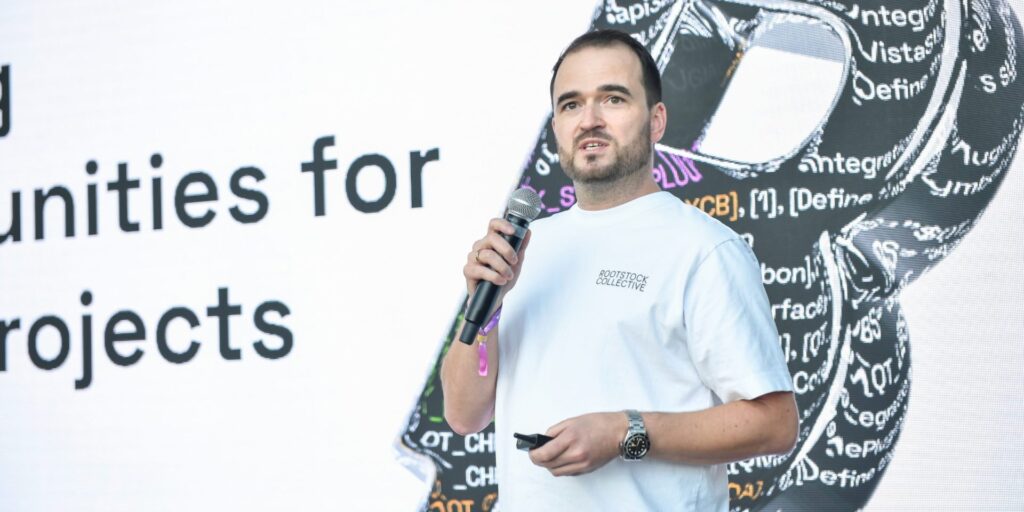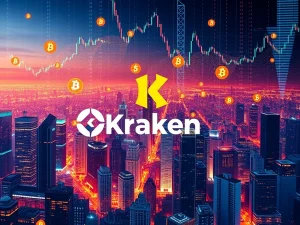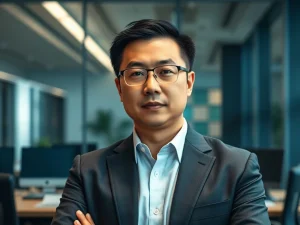With Pi42 by RootstockCollective

In an exclusive interview with BitcoinWorld, we got the chance to speak with Sascha Goetz, Founder of the RootstockCollective
What inspired the creation of RootstockCollective, and how does it align with the broader vision of Rootstock?
RootstockCollective was established to unlock Bitcoin’s full potential beyond its role as a store of value. By addressing Bitcoin’s untapped liquidity, it ensures fair value capture for builders while rewarding the backers and stakers who support these projects within the Rootstock ecosystem. RootstockCollective’s mission aligns with the larger goal of expanding the Bitcoin ecosystem, fostering innovation, and encouraging more projects to build on Rootstock, thereby broadening the range of Bitcoin-based products available.
Since the launch in September 2024, what has been the most surprising outcome or achievement for RootstockCollective?
The initial community response to the RootstockCollective exceeded our expectations, with 4.5 million RIF staked in the DAO within 24 hours. More broadly, the RootstockCollective has successfully supported several builder projects in just over three months – a remarkable achievement in such a short timeframe.
Take the Asami Club, for instance. This project focuses on social empowerment, offering cross-sponsoring and revenue opportunities via social media. Although their initial project didn’t work out with RootstockLabs, they secured grant funding through the DAO. Today, they actively engage with their community and champion the DAO’s potential, showcasing its value as ambassadors.
Another notable project is Memora, a blockchain-based time capsule that integrates smart contracts for significant life events. In a somewhat macabre but practical example, users can set up contracts tied to their passing, enabling the transfer of crypto assets post-mortem. As a winner at the ETH Global Hackathon in Singapore, Memora utilized DAO grants to advance their project.
These examples underline how RootstockCollective supports builders not just at the inception of their projects but also as they scale and grow, demonstrating the DAO’s ability to empower innovation within the Rootstock ecosystem.
How does the RIF token governance system work in practice, and how do you ensure inclusivity and fairness for participants?
Participation within the RootstockCollective is straightforward. One RIF token equals one vote, with a minimum of one token required to participate as a backer. Builders need at least 1,000 RIF to submit a proposal, ensuring serious applications and preventing spam. Transparency is a core principle of the Rootstock Collective, allowing anyone to track project progress within the DAO. A minimum of 4% community turnout is required for projects to receive funding, ensuring equitable participation.
While liquidity differences among backers present challenges, solutions such as a delegate system are being explored to empower those with smaller contributions. The DAO remains committed to inclusivity and fairness, and we are doing all we can behind the scenes to ensure this remains the case.
With $10 million in funding secured for the foundation’s treasury, what are your key priorities for allocation?
The DAO’s $10 million first-year funding primarily supports builders through Builder Rewards and grants, while rewarding backers through Backer Rewards. Additional initiatives include funding hackathon participants and offering community incentives like airdrops and quest campaigns. On top the DAO treasury receives 19% of all Rootstock transaction fees soon, creating a sustainable funding cycle. Through this approach we aim to foster innovation while rewarding community involvement.
What strategies are being used to engage and grow the Rootstock community further?
Rootstock’s community comprises both builders and end-users. For builders, Rootstock’s unique status as the only Bitcoin Layer 2 offering Ethereum-like capabilities makes it highly appealing. The platform’s support for hackathons and workshops has attracted global interest, as demonstrated by events like the ETH Global hackathons, where we’ve experienced a huge increase in projects developing on Rootstock throughout the year.
For end-users, often Bitcoin investors, there are some unique challenges to community growth. These users prioritize assurances about security audits and governance, seeking confidence that their assets are safe within the Rootstock ecosystem. Additionally, because they are less developer-focused, significant effort is directed toward raising awareness through social media and events. These initiatives are key to lowering Rootstock’s, and crypto’s barrier to entry, fostering inclusivity, and making the ecosystem accessible to newcomers.
What initiatives or incentives do you offer to encourage participation and reward active members of the DAO?
The CollectiveRewards program, launched in December 2024, addresses Bitcoin’s value capture problem. It works by asking the builders, who are seeking finance through the treasury, to designate a portion of their requested funds from the treasury to be given back to the backers. For example, if a project requests $5,000 in funding and allocates 50% to backers, $2,500 will be distributed among those who staked RIF voted for the project, proportionally split among voters. This approach encourages active engagement within the DAO, while ensuring all successful participants can profit – not just the builders.
Looking ahead, we have exciting plans in the pipeline for further incentives, including introducing new roles for active DAO members, gamification elements, and NFT-based rewards. I don’t want to say too much right now however, just know that we are always thinking of ways to incentivize and grow the community within the DAO and plan to add more of these over this new year.
As the first Bitcoin DAO to feature a Grants program, what challenges did you face in implementing it?
Building the RootstockCollective involved extensive testing to ensure its mechanics were robust and effective. While balancing funding and participation equality remains a challenge, the DAO’s iterative development process allows us to address and refine based on community feedback. We’ve done this already, with the initial community feedback at launch leading to updates like the CollectiveRewards program. These improvements are all steps toward aligning the DAO with its long-term vision.
We’re incredibly proud of how the DAO has evolved since launch. Already, we’ve hit double digits for positive proposals and grants handed out, and we’ve had a lot of requests from builders who want to submit proposals through the DAO. Depending on how voting goes for them, those numbers will only increase. As that happens, we’ll continue to improve and update the RootstockCollective ensuring it becomes even more effective and user-friendly.
RootstockCollective staked $550,000 within the first 24 hours and has now reached $800,000. What drove this rapid adoption, and what’s next for encouraging further staking?
Rootstock has been a trusted name for over seven years as the longest-standing Bitcoin Layer 2, which meant we already had quite a well-established community when we announced the DAO. This existing trust and enthusiasm played a significant role in giving RootstockCollective the strong start it enjoyed, with many users eager to dive in from the beginning.
To ensure the RootstockCollective grows, we’ve been quite vocal in our messaging through social media and Telegram, getting across what the collective can offer to users who are active within the Rootstock community. Right now, the DAO is in its infancy but activity is high. Now, it’s essential we maintain this level of activity to ensure the long-term success of the project.
What unique contributions do you see RootstockCollective making to the future of blockchain technology?
The RootstockCollective is seeing many talented builders who are putting forth innovative project ideas for dApps. I’m sure as we keep going forward, many of these projects will become more disruptive to the usual order of things and may help advance blockchain technology as a whole. When that happens, the RootstockCollective will be there to support them.
The most interesting area where the DAO may contribute to the future of blockchain technology is in the decentralization and governance process. Decentralization is a founding principle of Bitcoin and a core part of the blockchain. We are seeing many dApps appear on other chains that are taking a centralized approach, but with the RootstockCollective we are pushing for all projects to follow the decentralized bathway, growing the ecosystem and encouraging innovation.
What were the most significant challenges in launching RootstockCollective, and how were they addressed?
Projects like this take time and financial investment. At the start, it was a little difficult to completely visualize how we could put our theory into practice. We had to set-up the framework for the program: its structure, how it will look and the mechanics behind the scenes. Moreover,we needed that market validation from the community, which is hard to get until the project launches. We had to perform rigorous tests and market research to make sure all its features were things the community actually wanted.
In many ways, our initial launch last September felt like a pilot. It wasn’t until we gathered feedback from the community – learning what worked as intended and what needed adjustment – that we could refine the DAO to better align with our vision. This milestone was reached with the launch of the CollectiveRewards programme in December, marking a significant step forward in the RootstockCollective’s evolution.
What advice would you give to others building DAOs on Bitcoin Layer 2 solutions?
Successful DAOs require a clear mission that is aligned with the Bitcoin community’s ethos. Transparency and community trust are crucial, as is ensuring the project genuinely embodies DAO principles. Sustaining a DAO demands long-term commitment, continuous updates, and active community engagement. RootstockCollective exemplifies how a DAO can thrive as a community-driven project, fostering innovation and collaboration within the Bitcoin ecosystem.









